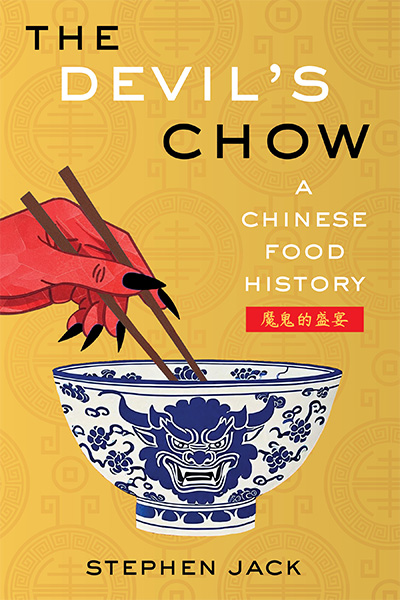THE DEVIL’S CHOW
A Chinese Food History

This Chinese food history book by Stephen Jack is newly released by Cold Press Books.
In The Devil’s Chow, Stephen Jack traverses China to tell the monumental story of how Chinese food evolved from the earliest times into the unique cuisine it is today. From the cave home of Peking Man to the deserts of the Silk Road; from the southern tribal borderlands to the country’s megacities, he reveals the ancient mysteries and the modern realities of Chinese food, perhaps the most sophisticated yet confronting cuisine in the world.
- Why do Chinese people cook with woks and eat with chopsticks?
- Do Chinese really eat dogs and cats?
- Why did pottery appear in China 13,000 years earlier than in the West?
- Did Marco Polo teach Italians to make spaghetti after discovering noodles in China?
- How did a chef in ancient times rise to become prime minister?
- Is chop suey a genuine Chinese dish or was it invented in America?
- With its vast population, why is China running out of farmers?
- Why are more than half of Chinese adults overweight or obese?
The Devil’s Chow is one of the few books for the general reader that tells the story of Chinese food history in its entirety.
PRAISE for The Devil’s Chow
“Despite all the books about Chinese food, every now and then there comes a masterpiece. The Devil’s Chow is a personal and moving encounter with Chinese food history is one of them. It is packed with fascinating anecdotes and stories on one of the world’s greatest cuisines. A book that deserves to be in the library of anyone who loves food!” –Ken Hom, CBE, Author, Chef & TV Presenter
“Stephen Jack’s book is a terrific read … His observations on the present, as he has experienced it, rather steal the show, but the history is strikingly accurate … The book maintains a fine balance between tales of the open road in China and historical and agricultural data. Once I started it, I couldn’t stop except to eat and sleep until I finished it. A great way to learn about Chinese food.”
–Professor Emeritus E. N. Anderson, author of The Food of China –Read Full Review
“Stephen Jack not only knows a hell of a lot about Chinese food; he also knows how to turn a phrase. He takes readers on a lively ‘Cook’s tour,’ … And like the best guides, he is part historian and part storyteller, with an infectious passion and enthusiasm for his subject. Don’t read this book on an empty stomach”
–Scott D. Seligman, co-author of The Cultural Revolution Cookbook –Read Full Review
EBOOK Out Now–Order Here
PAPERBACK Out Dec. 2025
EXCERPTS from the book
On the Invention of Chopsticks
“How a matching pair of thin sticks came to be used in one hand like tongs or finger extensions remains a mystery, but chopsticks have proved themselves ideal utensils for eating certain kinds of dishes. Chopsticks are such a simple device that their invention seems more a triumph of dexterity than of technology.”
On Baozi Buns
“A well-formed baozi has a pleated top that gives it the appearance of a puffed-up ivory flower. Baozi are cooked in distinctive circular lattice steamers; interlocking stacks of these can be seen at restaurants—bamboo chimneys billowing aromatic steam. The most succulent baozi are cooked to order and eaten right from the steamer.”
On Daoism and the Development of Chinese Food and Medicine
“Later, Daoists, in their quest for immortality, grabbed the reins of this alchemical tradition and rode it with a vengeance. Daoist seekers scaled misty mountains, crossed vast deserts and navigated the vagaries of the high seas, all to get their hands on exotic plants, creatures or minerals to experiment with. While the elixir of life eluded them, they discovered decoctions of death and sickness time and time again as potions despatched alchemists and sometimes even emperors.”
On the Spread of Chinese Culinary Ways Around the World
“Chinese is the most commonly eaten cuisine on the planet. Its role in sustaining China’s 1.4 billion people is enough to see to that, but its appeal, of course, doesn’t stop at the border. The distinctive aromatic blend of sizzling soy sauce, ginger and spring onions has wafted into just about every major settlement on earth. Over time, slowly but surely, stomach by stomach, the Chinese diaspora, armed with woks, cleavers and spatulas, conquered the world with their unique style of cooking.”
On Dim Sum
“My second dim sum dish of the day: cha siu bao, savoury-sweet roast pork encased in gaping steamed buns as fluffy as cumulus clouds. It was my final meal in China and I was thinking, this had better be good. And it was.”
ABOUT THE AUTHOR
Stephen Jack hails from Bendigo, Australia, home to one of the oldest Chinese restaurants in the world. A former train driver, teacher and journalist, he lives in Taiwan where he works as a copywriter, marketing consultant and writes about Chinese food. He has appeared on the television series Bizarre Foods, and his writing has featured in various publications.
中文書名: 魔鬼的盛宴
Library Categories: Narrative non-fiction, Chinese Food History, Chinese Food, Chinese Cuisine, Chinese Food Culture, China Travel, China History.
Amazon and the Amazon logo are trademarks of Amazon.com, Inc. or its affiliates.
